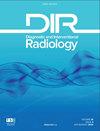土耳其共和国三级转诊医院多参数前列腺MRI采集中PI-RADS v2指南提出的最低可接受技术参数的符合性评估。
IF 1.7
4区 医学
Q2 Medicine
引用次数: 6
摘要
目的尽管多参数前列腺磁共振成像(mpMRI)的临床应用正在增加,但对mpMRI参数的遵守情况尚不清楚,该参数已在前列腺成像报告和数据系统第2版(PI-RADSv2)中描述,用于最佳图像采集。在本文中,我们旨在确定土耳其三级护理中心是否符合PI-RADSv2定义的前列腺mpMRI最低可接受技术参数。我们向土耳其三级转诊医院的所有放射科(n=120)发送了一份调查,以评估他们对PI-RADSv2技术规范的遵守情况。采用卡方检验、Fisher精确检验、方差分析和Student t检验进行统计分析。图像采集时间的截止值也通过ROC分析确定。P值<0.05被认为具有统计学意义。结果111家诊所对我们的调查做出了回应(回应率=92.5%)。据报道,61个中心进行了前列腺MRI检查。26个(42.6%)中心使用3T(特斯拉)扫描仪,35个(57.4%)中心使用1.5T扫描仪。T2WI对层厚(ST)、平面内相位和频率分辨率的粘附率分别为68.9%、41%和9.8%。DWI对相同参数的依从性高于T2WI(分别为85.2%、62.3%和78.7%)。在比较分析中,与1.5T扫描仪相比,3T扫描仪在T2WI上对ST段、视野(FOV)和平面内相位分辨率的依从性更高(分别为P=0.004、P=0.041和P=0.001)。坚持T2WI-FOV(P=0.034)和平面内T2WI相位分辨率(P=0.028)的中心的T2WI采集时间明显较长。坚持DWI-FOV(P=0.014)和b值≥1400s/mm2(P=0.008)的中心DWI扫描时间明显较长,计算出的T2WI截止值为220秒,DWI截止值为312秒,以确保符合体素大小和b值criteria。结论土耳其的三级转诊中心在前列腺MRI采集过程中不符合PI-RADSv2的大部分技术规范。应提高对mpMRI最低可接受技术参数的认识,以潜在地提高前列腺癌症成像的质量。本文章由计算机程序翻译,如有差异,请以英文原文为准。
Assessment of the compliance with minimum acceptable technical parameters proposed by PI-RADS v2 guidelines in multiparametric prostate MRI acquisition in tertiary referral hospitals in the Republic of Turkey.
PURPOSE
Although the clinical use of multiparametric prostate magnetic resonance imaging (mpMRI) is increasing, the adherence to parameters for mpMRI which had been described in the Prostate Imaging-Reporting and Data System version 2 (PI-RADSv2) for an optimum image acquisition is unknown. In this paper, we aimed to determine the compliance with the minimum acceptable technical parameters for prostate mpMRI defined by PI-RADSv2 in tertiary care centers in Turkey.
METHODS
We sent a survey to all radiology departments of tertiary referral hospitals in Turkey (n = 120) to evaluate their adherence to PI-RADSv2 technical specifications. Statistical analysis was performed using Chi-square, Fisher Exact, ANOVA, and the Student`s t tests. The cut-off values for image acquisition times were also determined with ROC analysis. P - values <0.05 were considered statistically significant.
RESULTS
One hundred and eleven clinics responded to our survey (response rate = 92.5%). Prostate MRI was reported to be performed in 61 centers. 26 (42.6%) centers used 3 T (Tesla) scanner while 1.5T was used in 35 (57.4%) centers. The adherence to slice thickness (ST), in-plane phase and frequency resolutions on T2WI were 68.9%, 41% and 9.8% respectively. The adherence to the same parameters on DWI were higher compared to T2WI (85.2%, 62.3% and 78.7%, respectively). In comparative analysis, the adherence to ST, field of view (FOV) and in-plane phase resolution on T2WI were higher for 3T compared with 1.5T scanners (P = 0.004, P = 0.041 and P = 0.001, respectively). T2WI acquisition time was significantly longer for the centers adhered to T2WI-FOV (P = 0.034) and in-plane T2WI phase resolution (P = 0.028). The DWI scan time was significantly longer when they adhered to DWI-FOV (P = 0.014) and b-value≥1400s/mm2 (P = 0.008). The calculated cut-off values were 220 seconds in T2WI and 312 seconds in DWI to ensure the compliance with voxel sizes and b-value criterias.
CONCLUSION
The tertiary referral centers in Turkey did not meet most of the technical specifications of PI-RADSv2 during prostate MRI acquisition. Awareness to the minimum acceptable technical parameters of mpMRI should be increased to potentially improve the quality of prostate cancer imaging.
求助全文
通过发布文献求助,成功后即可免费获取论文全文。
去求助
来源期刊
CiteScore
3.50
自引率
4.80%
发文量
69
审稿时长
6-12 weeks
期刊介绍:
Diagnostic and Interventional Radiology (Diagn Interv Radiol) is the open access, online-only official publication of Turkish Society of Radiology. It is published bimonthly and the journal’s publication language is English.
The journal is a medium for original articles, reviews, pictorial essays, technical notes related to all fields of diagnostic and interventional radiology.

 求助内容:
求助内容: 应助结果提醒方式:
应助结果提醒方式:


